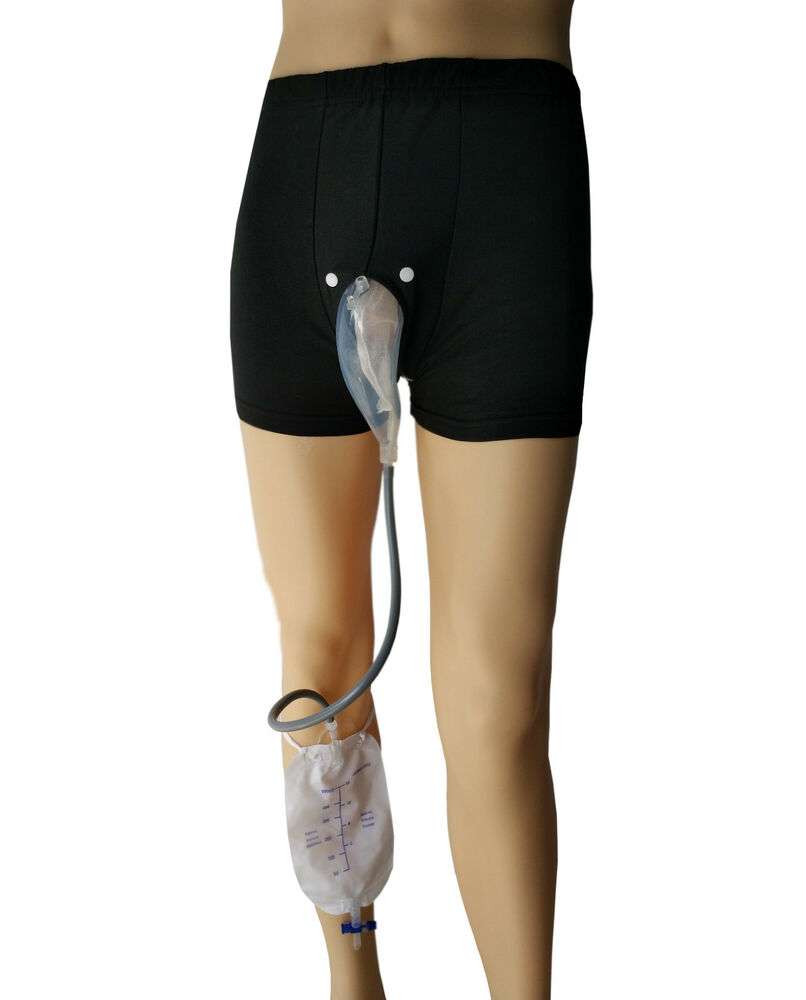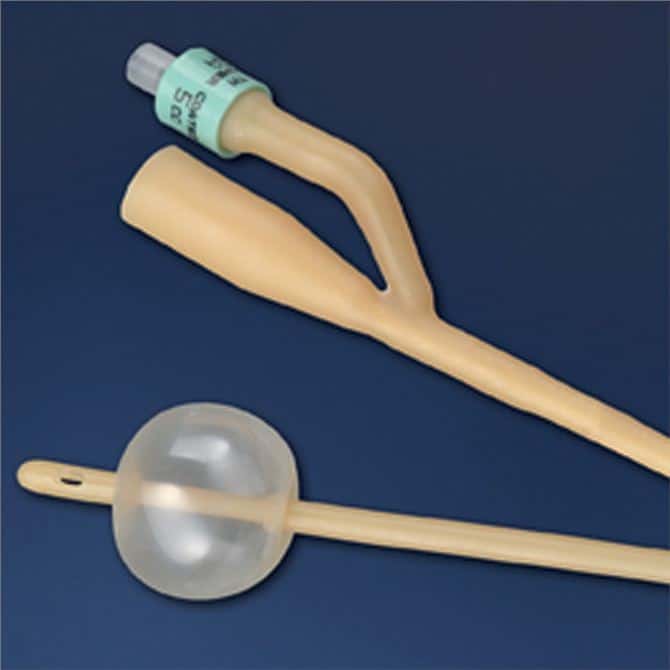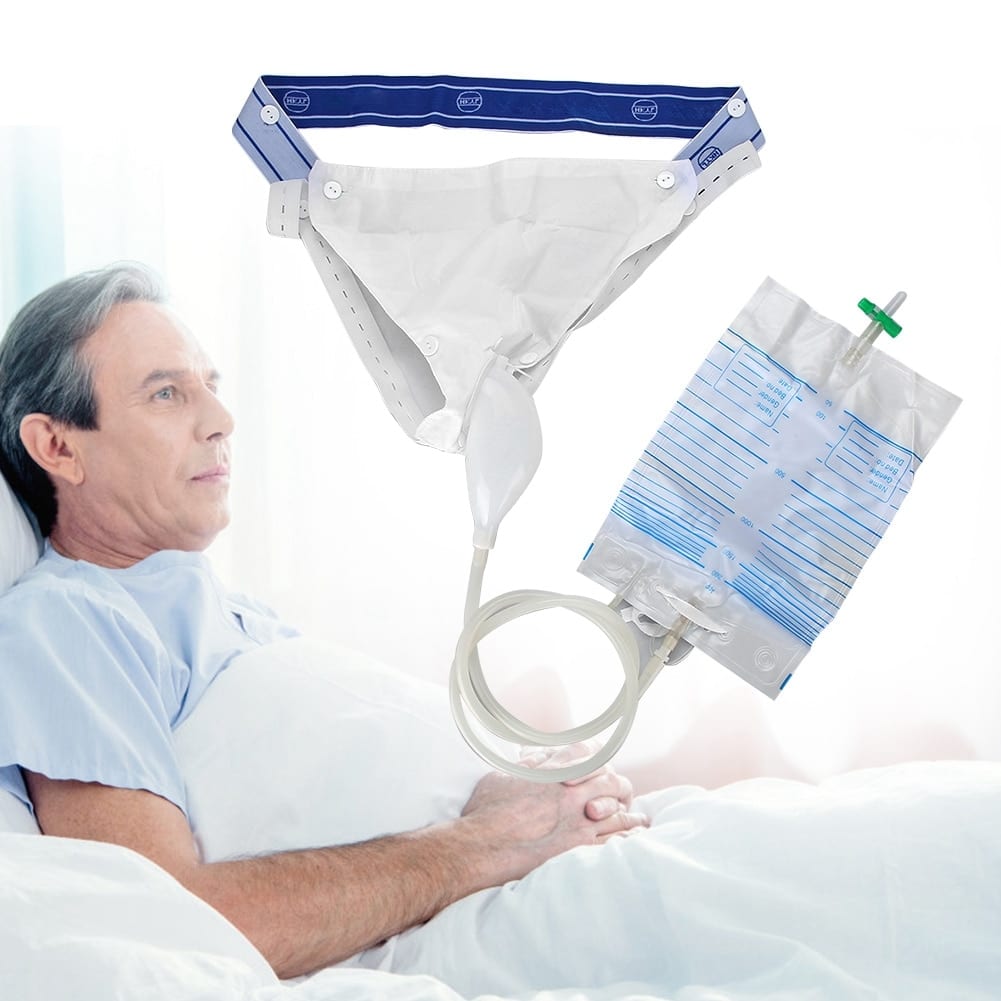Catheter Types And Sizes
Catheter sizes and types are as follows :
-
Adults – Foley catheter
-
Adult males with obstruction at the prostate – Coudé tip
-
Adults with gross hematuria – Foley catheter or 3-way irrigation catheter
-
Children – Foley to determine size, divide child’s age by 2 and then add 8
-
Infants younger than 6 months – Feeding tube with tape
Urethral catheter types: 1) Straight tip 2) Coude tip 3) 3-way catheter irrigation.
Catheter materials include the following:
Place the patient supine, in the frogleg position, with knees flexed.
Explain the procedure, benefits, risks, complications, and alternatives to the patient or the patient’s representative.
Position the patient supine, in bed, and uncover the genitalia.
Open the catheter tray and place it on the gurney in between the patients legs use the sterile package as an extended sterile field. Open the iodine/chlorhexidine preparatory solution and pour it onto the sterile cotton balls. Open a sterile lidocaine 2% lubricant with applicator or a 10-mL syringe and sterile 2% lidocaine gel and place them on the sterile field. See the image below.
Using a syringe with no needle, instill 5-10 mL of lidocaine gel 2% into the urethra. Place a finger on the meatus to help prevent spillage of the anesthetic lubricant. Allow 2-3 minutes before proceeding with the urethral catheterization. See the video below.
Urinary Catheter Insertion For Male Patients
Transcript
Hi there! Lets take a look at urinary catheters and catheter insertion for male patients.
A urinary catheter is a hollow, flexible tube inserted through the urethra into the bladder to drain urine into an external collection bag.
Once the catheter has been inserted, a small balloon on the internal end is inflated with sterile water to keep it in situ.
Catheters are used often in healthcare settings to assist with a variety of conditions, such as both urinary incontinence and urinary retention, or by patients who may be unable to go to the toilet without assistance.
Procedure
The following demonstration is based on the Catheterisation Clinical Guidelines by the Australia and New Zealand Urological Nurses Society.
Remember to always refer first to your organisations internal policies and procedures when performing any procedure like this one.
Details
Support Groups And Further Information
Living with a catheter can be challenging. You may find it useful to get more information and advice from support groups and other organisations.
For example, the charity Bladder and Bowel Community provides information and support for people with bladder and bowel conditions.
Page last reviewed: 26 February 2020 Next review due: 26 February 2023
You May Like: Urinary Incontinence And Kidney Disease
Urethral Vs Suprapubic Catheters
Suprapubic catheters are recommended by some physicians for short-term use when a catheter is needed for gynecologic, urologic and other surgeries.1 Theoretically, there are fewer microbes on the abdominal wall than on the perineum, creating less risk for infection. Another advantage is easier catheter changes. Suprapubic catheters can also be clamped to test for adequate voiding. Some patients might also prefer a suprapubic catheter to enhance self-image and sexual functioning. Other patients prefer its comfort and convenience.1 Disadvantages of suprapubic catheters include the risk of cellulitis, leakage, hematoma at the puncture site, prolapse through the urethra1 and the psychologic barrier of insertion through the abdominal wall.
What Are Male Intermittent Catheters

A male catheter is a thin flexible tube that you insert into the urethra or through a stoma to drain urine from the bladder.
The term intermittent means that the catheter doesnt stay in the bladder, like an indwelling catheter does. Intermittent catheters drain urine, then you withdraw them and throw them away after each use.
While in the early days of the first catheter invention, people may have used metal or glass tubes to self-cath, current catheters are very different and way more comfortable. Most catheters come in sterilized, body-safe materials such as vinyl , silicone, POBE, or red rubber latex. Additionally, as technology continues to advance, catheters continue to become more comfortable and discreet.
Don’t Miss: Diabetes And Urinary Tract Infections
External Catheters For Women
External catheters are also available for women. Theyre mainly used to manage incontinence and to allow early removal of internal catheters, thus lowering the risk of CAUTIs.
External catheters for women typically use a long, thin cylinder with a top layer of absorbent fabric thats positioned between the labia, against the urethra. Urine is absorbed through the fabric and into the cylinder where its suctioned into a holding canister. Adhesive pads placed on the lower abdomen hold the device in place.
These catheters are designed to be used in a lying or sitting position.
What Is A Urinary Catheter And What Is Used For
Urinary catheters are a common aid to empty the bladder. The catheter consists of a flexible small thin tube that allows urine to leave the bladder. Some catheters also provide an integrated bag to collect the evacuated urine. Catheters can be used for many different reasons, both for temporary and long-term use. The most frequent reasons that lead to practicing catheterization are:
- Urine retention, that is the difficulty to completely empty the bladder
- Urinary incontinence, which is the involuntary loss of urine
- Surgical interventions
In all cases where the process of evacuating the urine is prevented by a lack of muscle contraction, anatomical and/or functional obstacles of the urethra, long-term catheterization will be necessary.
Also Check: Mrx Rc Feline Urinary So
When Urinary Catheters Are Used
A urinary catheter is usually used when people have difficulty peeing naturally. It can also be used to empty the bladder before or after surgery and to help perform certain tests.
Specific reasons a urinary catheter may be used include:
- to allow urine to drain if you have an obstruction in the tube that carries urine out of your bladder . For example, because of scarring or prostate enlargement
- to allow you to urinate if you have bladder weakness or nerve damage that affects your ability to pee
- to drain your bladder during childbirth if you have an epidural anaesthetic
- to drain your bladder before, during or after some types of surgery
- to deliver medicine directly into the bladder, such as during chemotherapy for bladder cancer
- as a last resort treatment for urinary incontinence when other types of treatment have been unsuccessful
Depending on the type of catheter you have and why it’s being used, the catheter may be removed after a few minutes, hours or days, or it may be needed for the long term.
Caring For The Drainage Bag
Clean your drainage bag once every two days with a mixture of vinegar and water. Follow these steps:
Use a new drainage bag every monthor sooner if there is a leak. Throw old drainage bags and tubing into the garbage.
Read Also: Spinal Stenosis And Urinary Retention
Preventing Infections And Other Complications
Having a long-term urinary catheter increases your risk of developing urinary tract infections and can also lead to other problems, such as blockages.
To minimise these risks you should:
- wash the skin in the area where the catheter enters your body with mild soap and water every day
- wash your hands with soap and warm water before and after touching your catheter equipment
- make sure you stay well hydrated you should aim to drink enough fluids so that your urine stays a pale colour
- avoid constipation staying hydrated can help with this, as can eating high-fibre foods, such as fruit and vegetables and wholegrain foods
- avoid having kinks or bends in the catheter and make sure any urine collection bags are always kept below the level of your bladder
Read more about the risks of urinary catheterisation.
Why Urinary Catheters Are Used
A urinary catheter is usually used in people who have difficulty passing urine naturally. It can also be used to empty the bladder before or after surgery and to help perform certain tests. Specific reasons include:
- to allow urine to drain if you have an obstruction in the tube that carries urine out of the bladder for example, because of scarring or prostate enlargement
- to allow you to urinate if you have bladder weakness or nerve damage which affects your ability to pee
- to drain your bladder during childbirth, if you have an epidural anaesthetic
- to drain your bladder before, during and/or after some types of surgery, such as operations on the womb, ovaries or bowels
- to deliver medication directly into the bladder, such as during chemotherapy for bladder cancer
- as a treatment for urinary incontinence when other types of treatment havent worked
The catheter will be used until its no longer needed. This may be for a short time and will be removed before leaving hospital, or it may be needed for longer or even permanently.
Don’t Miss: What Is Best To Drink For A Urinary Tract Infection
The Best Way To Prevent Pinching Pain Entirely
No matter how your catheter is inserted, there is a way to completely eliminate the pinching/sucking of the catheter tip. And that is to use a new type of catheter called The Duette. You can read more details about it here: The Duette A Better Catheter Than The Foley. But the bottom line is unlike the standard Foley catheter , the Duette has 2 balloons with the inlet holes in between them. This means there is no tip at the end to stab the interior of your bladder and to suck on the bladder wall. With the Duette, the little inlet holes cant make contact with your bladder wall , and so not only will you not get the pinch pain, but your risk of catheter induced UTI is reduced due to the reduced trauma. See the video on my article about the Duette.
Living With A Catheter

Some people may find living with a catheter challenging and uncomfortable at first. However, as people become more accustomed to the catheter, they generally find that it has less impact on their daily lives.
This section provides tips on how to prevent and overcome some of the possible complications of catheter use.
Don’t Miss: Implantable Device For Urinary Incontinence
What Type Of Catheter For Men Is Best
When it comes to catheters, no single type or size works for everyone. Thats why we suggest talking to your doctor about your needs. They can assess your condition and recommend what may work best for you.
Our Product Specialists are also more than happy to help you find the right intermittent catheter for you! As true experts in the catheter industry, were glad to be a trusted resource and support system as you determine what kind of male catheter product works best for your individual needs.
Contact us today or give us a call at 1-877-688-2729. Wed love the opportunity to discuss male catheters with you!
How Does The Bladder Work
The bladder is a bag in which the urine is collected before being evacuated through the urethra, through a several centimetres long passage. A perfectly functioning urinary system allows the body to regulate normal urination, but some circumstances can interrupt this process.
The cause might be a disease or an injury affecting the capacity of emptying the bladder in a normal way, such as a spinal cord injury, spina bifida, multiple sclerosis, Parkinsons disease, diabetes, enlarged prostate or stroke. In these cases, catheterization can become part of the daily routine.
Don’t Miss: How To Clean Urinary Tract
When To Get Medical Advice
Contact your community nurse , your GP surgery, or NHS 111 if:
- you develop severe or ongoing bladder spasms
- your catheter is blocked, or urine is leaking around the edges
- your urine is bloodstained or has specks of blood in it contact your community nurse if you continue passing bloodstained urine, or urine with blood specks
- you’re passing bright red blood
- you have symptoms of a UTI, such as lower abdominal pain, a high temperature and you feel shivery
- your catheter falls out
Read more about the risks of urinary catheterisation.
How To Use A Urinary Catheter
The most adequate procedure is explained by healthcare professionals during the training period and depends on the type of catheter used. Therefore, it is always important to rely on the competence of the professional for any clarification.
In all cases it is recommended to practice catheterization on a regular basis following the medical prescription. Certain amounts of residues in the bladder can cause different complications.
For more information you can download our PDF guide “Bladder management and intermittent catheterization for men” by pressing the button below.
Recommended Reading: How Serious Is A Urinary Tract Infection
Latex Vs Silastic Catheters
Silastic catheters have been recommended for short-term catheterization after surgery. Compared with latex catheters, silastic catheters have a decreased incidence of urethritis and, possibly, urethral stricture.18 However, use in animal models for longer than six weeks showed no difference in inflammatory response between latex and silastic catheters.18 Because of its lower cost and similar long-term outcomes, latex is the catheter of choice for long-term catheterization. The cost differential becomes less significant in patients who do not require frequent catheter changes.6 Silastic catheters should be used in latex-allergic patients.
Catheters impregnated with various substances have not proved to be beneficial in patients with long-term catheterization. Silver-impregnated catheters, antibiotic-coated catheters and electrified catheters may diminish bacteriuria for a few days but are costly and have no role in long-term catheterization.4,19â21 In one study, silver-impregnated catheters were associated with more frequent bacteriuria and an increased risk of staphylococcal bacteriuria.21
Recommendations For The Correct Use Of The Intermittent Catheter
To ensure your wellbeing while practicing catheterization it is advisable to follow some simple recommendations:
- A proper hand- and intimate hygiene are fundamental to prevent possible bacterial infections, called urinary tract infections . As other infections, if not treated in time they can cause complications.
- Drinking is important: our body needs to take 1,5-2 liters of liquid per day. This fluid travels into the bladder and reduces the risk of infections.
- Completely empty the bladder several times a day, the regular emptying of the bladder helps to prevent catheter associated urinary tract infection and possible kidney damage.
Minimizing the risk of infections and incontinence helps to enjoy a peaceful life and regain control of daily routines: it reduces the frequency of visits to the toilet and avoids unnecessary worries about urine smells or wet clothes.
Recommended Reading: What Is Urinary Tract Disease
How To Insert A Catheter
This article was medically reviewed by Sarah Gehrke, RN, MS. Sarah Gehrke is a Registered Nurse and Licensed Massage Therapist in Texas. Sarah has over 10 years of experience teaching and practicing phlebotomy and intravenous therapy using physical, psychological, and emotional support. She received her Massage Therapist License from the Amarillo Massage Therapy Institute in 2008 and a M.S. in Nursing from the University of Phoenix in 2013.There are 9 references cited in this article, which can be found at the bottom of the page.wikiHow marks an article as reader-approved once it receives enough positive feedback. This article received 28 testimonials and 87% of readers who voted found it helpful, earning it our reader-approved status. This article has been viewed 927,862 times.
Types Of Urinary Catheter

There are 2 main types of urinary catheter:
- intermittent catheters these are temporarily inserted into the bladder and removed once the bladder is empty
- indwelling catheters these remain in place for many days or weeks, and are held in position by an inflated balloon in the bladder
Many people prefer to use an indwelling catheter because it’s more convenient and avoids the repeated insertions needed with intermittent catheters. However, indwelling catheters are more likely to cause problems such as infections.
Inserting either type of catheter can be uncomfortable, so anaesthetic gel may be used on the area to reduce any pain. You may also experience some discomfort while the catheter is in place, but most people with a long-term catheter get used to this over time.
Read more about the types of urinary catheter.
You May Like: Difference Between A Urinary Tract Infection And A Bladder Infection
What Is A Catheter For Intermittent Catheterization
Hydrophilic catheters are characterized by the presence of a coating linked to the structure of the surface. This substance which is an integral and constituent part of the surface layer of the catheter is hydrophilic and thereby absorbs and binds the water molecules, which causes the surface of the catheter to become smooth and slippery.
Since the process is easier than indwelling catheterization, it can be learned with a simple training that facilitates the practice of self-catheterization. In fact, people who use these types of intermittent catheters can empty their bladder autonomously. This kind of catheterization guarantees independence, reduces the risks of infections and other complications – which is the reason why it is becoming more in use.
When An Internal Catheter Is More Appropriate
Condom catheters arent helpful if urine cant drain out of your bladder. In that case, an internal catheter is needed to bypass whatever is stopping the urine flow.
Conditions where an internal catheter is used include:
- Urinary retention. This condition prevents you from completely emptying your bladder.
- Neurogenic bladder. A nerve problem, like a spinal cord injury or multiple sclerosis, can also prevent your bladder from emptying.
- Urinary tract blockage.Bladder stones and urethral strictures can block urine flow.
Don’t Miss: Goat Urinary Tract Infection Treatment